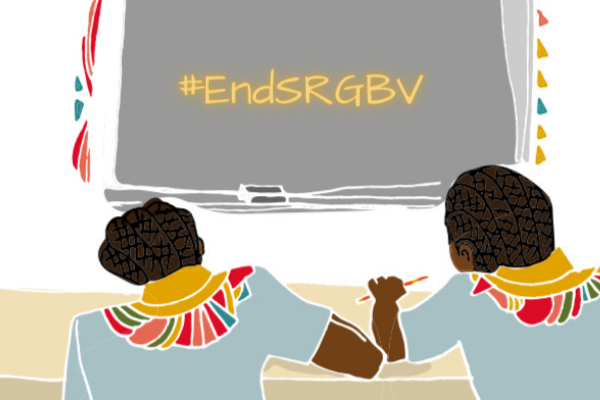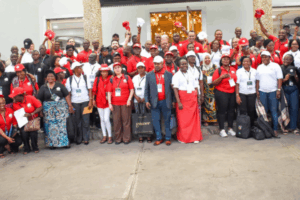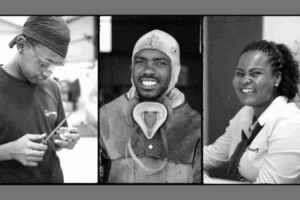UNICEF, through the UNGEI, and the targeted members of Education International have created frameworks to sustain the engagement by education unions in parts of sub-Saharan Africa and other regions with the ultimate goal of enhancing the safety and security of male and female children, youth and teachers in educational settings around the world. Unions in seven countries (Ethiopia, Kenya, Uganda, South Africa, Zambia, Sierra Leone and The Gambia) have been testing an innovative approach that aims to empower union members to create and sustain schools as safe spaces for teaching and learning.
SRGBV can be defined as “acts of sexual, physical or psychological violence inflicted on children in and around schools because of stereotypes and roles or norms attributed to or expected of them because of their sex or gendered identity.”
“The root causes do not lie in any one culture, tradition or institution, but in the wider structural issues, social norms and deep-rooted beliefs and behaviours and daily practices that shape gender and authority.”
UNESCO discussion paper (Nov 2013)
Collaborating Partners
Since 2004, Gender at Work has sought to bring together diverse theoretical and practical approaches to help organisations to understand and respond to gender power dynamics in their organisational practices and cultures.
What are we learning about dealing with violence and trauma?
SADTU’s workshop with life orientation educators uncovered the trauma that teachers have to deal with. When educators were asked to reflect on the impact of SRGBV on learners and how they dealt with it, most of them broke down and chose to speak of their own trauma. We discovered that they have never had an opportunity to process the trauma. Cultural factors also have an influence in this lack of processing, as does the fact that people have not had the community resources like Tai Chi (an ancient Chinese discipline involving a continuous series of controlled usually slow movements designed to improve physical and mental well-being) to deal with such trauma.
“We had to create a space for teachers to open up about their pain, and these are the very same teachers who are expected to deal with the trauma of others.”
Veronica Hofmeester, VP of Education at SADTU
Creating spaces to talk about pain
What are we learning about organising and representation?
Unions invest a lot of resources in training shop stewards to be excellent advocates because a union’s strength is based on its ability to represent and defend its members. If the union wins cases it grows its profile and therefore attracts more members.
“We need to shift the mindset of our members. SRGBV calls on all of us to see and feel with our hearts. We invest a lot of our energy and resources training SADTU shop stewards to represent members.”
Dorcas Sekabate, VP of Gender at SADTU
One of the strategies used by change teams was to restructure the shop steward training to also include training on empathy, ethics and the constitutional right of a child.
“School-related gender-based violence is a new issue on the teachers’ union agenda. From now on it will feature in the review of our constitution, policies and ethics. This will influence how we operate as organisations.”
(Aubrey - NAPTOSA, 2017)
Ensuring safety and non-violence is crucial for achieving educational outcomes. However, many schools face similar challenges, including issues with physical infrastructure, safety and security, management and governance, gangsterism and violence, drug abuse, and the need for partnerships. These problems affect the safety and security of both teachers and learners. To address these concerns, many schools have partnered with police services, linking them with local stations and establishing functional School Safety Committees. Unions must act to ensure that their members work in decent and secure conditions.
Teachers’ unions and their members play a vital role in preventing violence against learners but need more support from other community stakeholders. They can be key allies in stopping this abuse. Schools are ideally positioned to foster an environment of non-violence, tolerance, and gender equality. Teachers are central to this transformation, both through their actions and the curriculum they deliver.
It’s essential that teachers work in an environment where they are respected and their dignity is upheld, which means they must have safe working conditions. No teacher should face physical abuse in the workplace. This initiative should be integrated with other ongoing projects at the school level to create a cohesive and supportive environment.
What are we learning about keeping SRGBV on the union agenda?
“The adoption of a gender policy was a big step forward – as with the gender policy there is now a focus on the engagement of women, on women’s participation in the union, on women and men working together, on changing the mindset of women and importantly there are now Women’s Committees at national, provincial and district levels.”
Leah Kasaji, Gender Director at ZNUT
“With SRGBV in the gender policy, we will not only be influencing the actions of the union but this will also be a way of putting the issue on the agenda of other role players for example government. We are able to influence government education policies.”
Herbert, ZNUT, 2017
“We had what we called a ‘power hour’ with 100 teachers speaking about GBV and what happens in schools. We challenged the idea that education equals experts and outsiders. We always invite ‘experts’ to do presentations while we are also experts in our own right. We had flip charts all around the room with different questions and participants were asked to tick boxes and identify statements they agree with. They moved around the room, ticking and writing. They never had a chance to sit down like they were expecting. We are negotiating to have ‘power hours’ as part of the branch agenda.”
Aubrey - NAPTOSA, 2017
Participants then engaged with some of the very specific statements and comments on the flipcharts. The feedback was very positive. At the end of the session there were requests for materials that could assist the principals and teachers take the discussion forward.
What are we learning about union education work in relation to SRGBV?
“The survey revealed that teachers (our members) are the main perpetrators. It showed that there is a culture of physical beating which has become a norm in society. Parents think that if you do not beat your children you are “spoiling them."
Angela Chisanga, BETUZ, 2017
"We do not walk into a school to start a club – but rather we focus on getting the whole school involved. We get teachers interested to start the club through the school sensitisation programme and also work with guidance teachers to support club champions as they are well equipped with counselling skills.”
Bridget, BETUZ, 2017
By conducting a survey, SADTU was trying to understand the nature and extent of SRGBV in schools in South Africa, as well aiming to identify and develop strategies and interventions to root out SRGBV and create a safe and conducive learning environment. The results of the survey will be mainly used to develop strategies to make school premises and their surroundings free of SRGBV.
What are we learning about how unions are responding to SRGBV?
We need a curriculum approach and education that encourages learners to question and challenge violence. Learners need to be able to recognise what constitutes violence and abuse and how to protect themselves from harm. Unions need to be at the forefront of advocating for the provision of safe, accessible and confidential procedures to report incidents of SRGBV, to assist victims and to refer cases to appropriate authorities. Addressing a complex issue such as SRGBV requires a comprehensive response in collaboration with many stakeholders. National action on SRGBV should be informed by research, data and ongoing monitoring of progress.
What are we learning about collective bargaining in the public sector with teacher unions?
“Unions are leading the way in eradicating violence against women at work, and the support of a strong international legal instrument is essential.”
Sharan Burrow, ITUC General Secretary, 2017
BIBLIOGRAPHY
- UNESCO and UN Women “Global guidance – School-related gender-based violence”, 30 November 2016
- Kate Jere: “School-related gender-based violence is a major barrier to education equality”
- Faan Coetzee and Samantha Kelly: “Giving unions greater access to organizational rights”, 9 May 2013
- Bluidson, Peru Training the Teacher, 2015
- Peer Learning and Mentoring notes, 2017
- Gender-Based Violence at Work and at Home – A Trade Union Issue – Adopted resolution at the ETUC Executive Meeting of 13 and 14 December 2017.
- UNGEI- UNESCO discussion paper November, 2013.ni
- Research Officer UNESCO 13 May 2015.
Learn more: Working with teacher unions to end school-related gender-based violence.
RELATED RESOURCE
Strategies to end SRGBV: The experience of education unions in Africa
Video: Education Unions Take Action to End School-Related Gender-Based Violence in Africa







